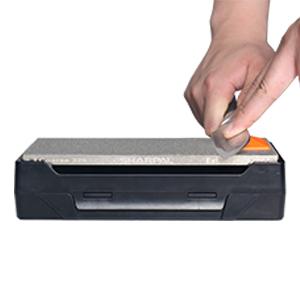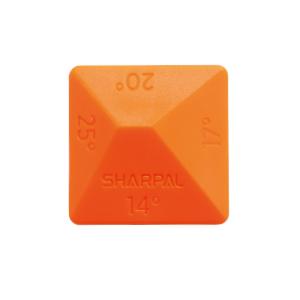Kundendienst
Copyright © 2025 Desertcart Holdings Limited
Desert Online General Trading LLC
Dubai, United Arab Emirates







🔧 Elevate Your Edge – Because Every Chef Deserves Precision!
The SHARPAL 196N ANGLE PYRAMID Whetstone Knife Blade Sharpener is a versatile 2-pack sharpening solution featuring four universal angles (14°, 17°, 20°, 25°) for professional-grade blade sharpening. With a magnetic base for ferrous stones and an anti-slip pad for traditional stones, this lightweight tool ensures stability and precision, making it an essential for any culinary enthusiast.







| Grit Type | Extra Fine |
| Color | Black and Orange |
| Material | Plastic |
| Item Weight | 18 Grams |
| Item Dimensions L x W x H | 3.14"L x 1.6"W x 0.3"H |
F**R
Useful tool for both new and experienced sharpeners
The two guides included in the Sharpal 196N package are excellent tools for finding the correct angle to use when sharpening a knife on a diamond plate or a sharpening stone. Even an experienced sharpener sometimes needs a guide.The orange pyramid guide has an embedded magnet that will allow the guide to attach and stay put on most diamond sharpening plates (also called whetstones). My pictures show the orange guide on a Sharpal 162N diamond whetstone. (Note that the 162N whetstone comes with the orange guide included.) However, many brands of diamond coated whetstones have the diamonds embedded in a layer on a steel plate, so the orange guide should work just fine with them.To use the orange guide, select the angle you want for the knife, then put the guide on the diamond whetstone with that angle facing the long side of the whetstone. Diamond whetstones can be used to sharpen a knife by putting the knife on the stone at the selected angle, then maintaining that angle while moving the knife in a "slicing" motion across the whetstone, as though you were trying to slice off the diamond coating. The amount of pressure on the whetstone is four pounds or less. If you have a kitchen scale, you can get a feel for how much force is equal to four pounds. (Believe me, it isn't much.) When in doubt, use less force and go across the stone more times.Do about 8-10 strokes on one side, then flip the knife over and do 8-10 strokes on the other edge. Most people will use the same hand for both sides of the knife, which means you would relocate the orange guide to the other end of the whetstone. Some ambidextrous folks can simply switch hands to sharpen the other edge of the knife.My photo shows 20° selected for use. Most western knives would use a 20° angle. Use a 14° angle for most Japanese-style knives (Shun, MAC, Tojiro, Dalstrong, etc.). The 17° guide might be more appropriate for a Global. If unsure, consult the description for the particular knife at the manufacturer's website or wherever the knife was purchased. Check to see if there is an Amazon description, too.The 25° angle is appropriate for cleavers and some chef knives. This larger angle will not get the edge as sharp as a narrower angle, but the edge will be more difficult to roll over, if you are using a lot of force during your cutting activities.The black guide is shown on a 3000 grit Pride Abrasive water stone. It has a rubbery bottom that helps prevent the guide from slipping on the stone. Most water stones require you to pull the edge across the stone by having the top of the knife moving forward and the sharp edge trailing behind. In other words, you are dragging the edge away from the stone surface, not trying to slice off the top of the water stone - many brands of water stones are soft enough that you actually would cut into the stone. So, to use the black guide, you need to put the knife on the desired angle and observe how the knife looks relative to the stone. Then you lift the knife off the guide while maintaining that angle, put the knife on the stone and dragging the edge across the stone.I realize that this description may not adequately explain the process, so I suggest that you watch some online videos. You can search for videos by Peter Nowlan that I watched when I first began sharpening. Peter does not use angle guides, but you can learn the basic techniques and incorporate the angle guide into your own process.
K**R
Small enough to carry
Handy to get the correct angle for sharpening different knifes and tools. Works like it should. You get 2 1 for shop other put in your backpack.
J**T
Simple, yet useful tool.
Angle guides are really useful to a sharpening newbie, practically a necessity. This was the most cost efficient set I could find. Just 2 little pyramids (one with magnets, one with anti slip base) each with the same 4 angles, 14°, 17°, 20°, and 25°. No tricks or tips, just drop the guide in place and go. My only issues were the bases on these guides. The magnet in the orange one was very weak, and it would easily move around when bumped. I immediately pulled the magnet out and replaced it with stronger neodymium magnets, held in place by epoxy. The anti-slip pad on the black one makes it sit a little higher than it should, which is fine for larger blades, but doesn't allow narrow blades much contact to the ramp (not a big deal since I use the orange one mainly).
R**Z
Great for any beginner.
I work in a beef plant so having a good edge on my knife is very important. Quality of this is great, love the rubber and the magnet that help keep it on the stone. Extremely easy to use. I used angle 25 and good lord never knew my knife could cut meat like that, but I prefer angle 20 so performance is great. Angles on it are great. Value is not expensive it's a good buy. Fits in my little pocket I have where I keep my stone.
I**W
Useful for getting setting proper sharpening angle, but appear to scratch the side of the blade
The rubber based one stays put on the stone so it's easy to use. Hard to really be sure the knife is properly set against the block, and once moving it's easy to wobble the knife edge and not maintain the correct angle. But biggest issue is they appear to scratch the knife. Our nice expensive Japanese steel knife has lots of little scratches along the blade that I don't believe are from the stone, they appear to be from these blocks.
I**'
Pretty good
I ordered this angle guide to help me find the angle for which to sharpen my Japanese Style Knife. I specifically use it to get the closest approximation of the correct angle. The guide itself has a fourteen degree angle guide. My knife requires a 15 degree edge. So I make a slight adjustment and mark my fingers with an ink pen to get consistent strokes. Please be aware that I don't use the guide placed on the stone itself. I have excellent results from the using the angle guide in this manner. For me it works.
A**.
A very useful little aide for sharpening cutting tools!
These Sharpal 196N ANGLE PYRAMID Whetstone sharpening angle guides are very useful for in concert with whetstone's. I destroyed edges of knives and cutting tools many times over the years until I discovered angle guides and the different angles required on different knives and tools. I ordered these for use when sharpening chisels and gouges on whetstones. They take the guess work out of getting the angle correct for the knife or tool you are sharpening on a stone. You simply place the guide at one end of the stone, lay the blade against the correct and which is facing the opposite end of the stone and follow through while maintaining that angle. It will seem a bit odd at first but, becomes natural quickly. This simple little aide not only saves much frustration but, saves a lot of time in the sharpening process once you start using them. You achieve a sharper edge much quicker. You only need to know which angle is required for the knife or tool you are sharpening to make this work perfectly. The Sharpal 196N ANGLE PYRAMID Whetstone guides are a useful tool that can be stored or carried anywhere. I consider them a very good value for the cost!
TrustPilot
vor 1 Monat
vor 4 Tagen